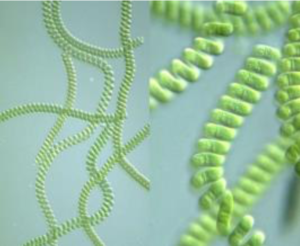Pool Algae
Black algae

Black algae are not actually algae, but bacterium with photosynthetic pigment, the group or Phylum are referred to as Cyanobacteria, and while they are not normally pathogenic, they can be extremely toxic and are linked to neurological disease as well as sensitised skin reactions.
Black algae in a swimming pool are therefore not only unsightly, contact with it can be dangerous. A common Cyanobacteria in swimming pools is a Phormidiaceae for which there are many different species. The size of the bacterium ranges from 0.5 microns to 60 microns, and is the largest Prokaryote cell (cells with no nucleus or internal membranes). The bacterium also forms chains and mats that give the appearance of a black mat or stain on concrete as well as the tiles and most especially the grout between the tiles.
Understanding what the bacterium requires from the environment is a key to understand how to deal with the problem in swimming pools.
The grout between the tiles, tiles that have been corroded by sulphates, concrete, and gel coat on fibreglass are all micro-porous. The bacterium will live on and inside the surfaces, so no amount of scrubbing with a brush will remove the bacterium. The surface bacterium will be removed, but it will quickly return from below the surface.
Hypochlorite may be used and will certain be effective when used at a high concentration. However, through a process of natural selection the bacterium will become resistant, and will again return. The key is the choice of disinfectant used and the quality of the water.
Water quality
Phosphate
The better the quality of the water, the lower the concentration of nutrients and the more difficult it is for the bacterium to grow. One of the key nutrients is phosphate, remove the phosphate and you almost stop all bacterium and algae growth. For this to work, NoPhos may be used to lower the phosphate concentration to zero.
Treatment with NoPhos must continue, even when the concentration is zero because phosphate can enter by lysis of bacterium and algae, and will introduce organic phosphate back into solution. The dissolution of inorganic phosphate minerals such as calcite or struvite will also introduce more phosphate. So, keep up the NoPhos addition and insure
Dryden Aqua Ltd. www.drydenaqua.com
1
that phosphate concentration is always zero. The cyanobacteria will gradual start to disappear, but it will take around 6 weeks before you start to notice the effect.
Oxidation
Hypochlorous is not effective against cyanobacteria, however chlorine dioxide works well. Chlorine dioxide works because it is lipid soluble and diffuses through the cell wall and oxidises the cell wall structure. It is very difficult, to impossible, for cyanobacteria to become resistant to chlorine dioxide. DryOx is a tablet form of chlorine dioxide, 1 tablet delivers 2g, even a low concentration of no more than 0.4mg/l for several hours will deal with cyanobacteria, it will kill the bacteria on the surface as well as in the porous structure of the pool surfaces.
Treatment with DryOx should be started at night when there is no direct sunlight on the pool. One tablet is used for every 5m3 of water for a cyanobacterium treatment. The treatment should be repeated every 4 to 12 weeks.
ACO
Dryden Aqua ACO® acts as a sun block for water, cyanobacteria grow on the surfaces on the base of the pool, and they need sunlight. ACO® removes some of the wavelengths of light required by the algae, and as such it slows down the growth rate.
ACO® also generates hydroxyl radicals that oxidise by electron abstraction. Just like Chlorine dioxide it is impossible for cyanobacteria to develop resistance to free radical oxidation by electron abstraction.
Summary
The solution to controlling cyanobacteria (Black Algae) in swimming pools is to ensure that you have the best possible water quality, and Dryden Aqua DAISY system will deliver the best water in the pool industry.
The use of NoPhos in combinations with DryOx and ACO® as part of the Dryden DAISY® system is the solution. If cyanobacteria return, then it may be required to reduce the dosing frequency of DryOx to a shorter time frame. It will also be a requirement to measure the phosphate concentration and make sure that there is no phosphate in the water.
All other approaches relay upon a great deal of scrubbing and toxic chemicals including algaecides containing copper or even more toxic chemicals. The Dryden Aqua approach tackles the problem at source and allows it to be controlled and eliminated in a safe environmentally sustainable manner.
